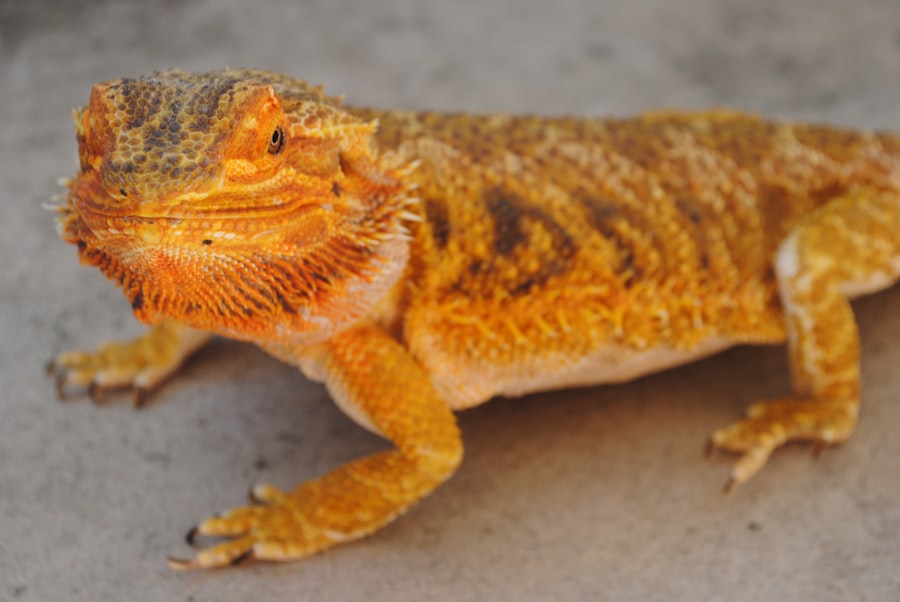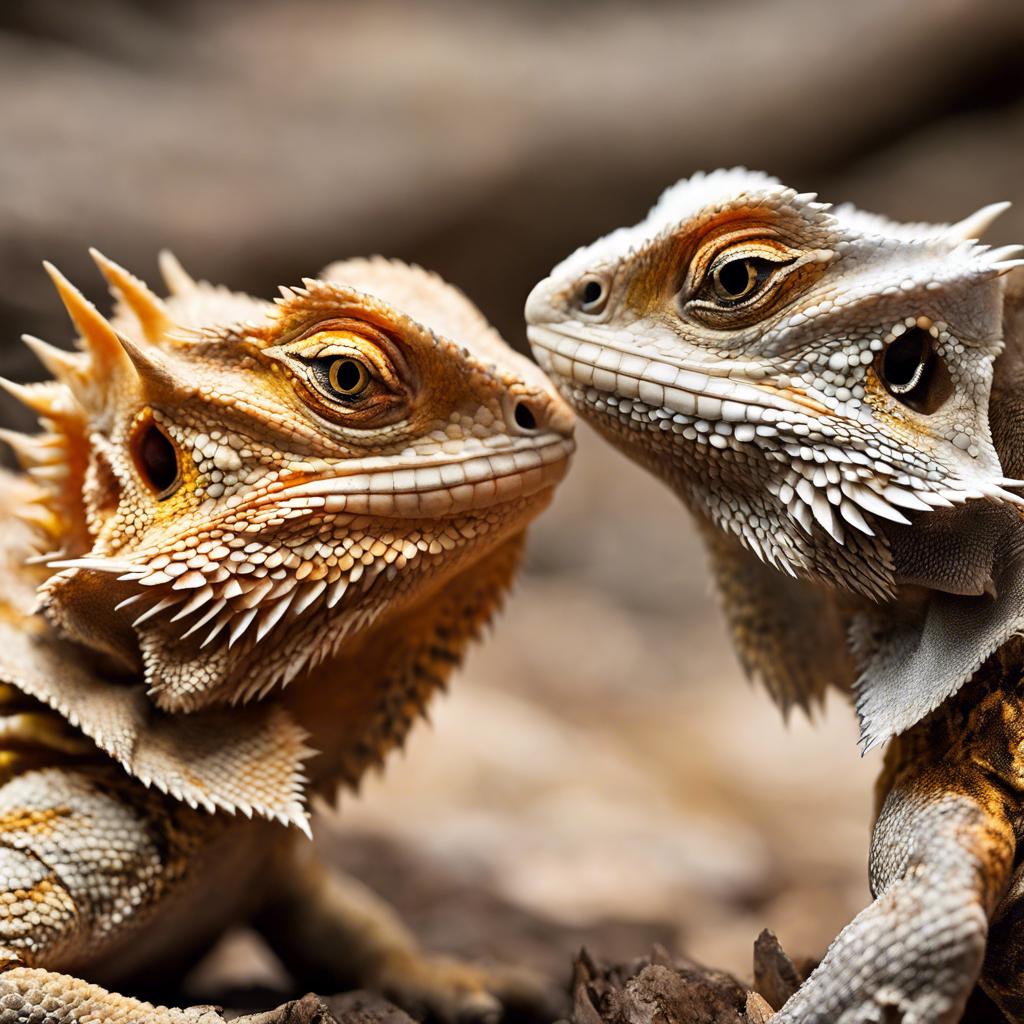Bearded dragons are popular reptile pets known for their unique appearance and docile nature. These reptiles are native to Australia and are named for the spiky beard-like scales on their throats that they can puff out when threatened or displaying dominance. While bearded dragons may all look similar at first glance, it is important for owners to understand the differences between males and females. This knowledge is crucial for providing proper care and ensuring the well-being of these fascinating creatures.
Key Takeaways
- Male bearded dragons are typically larger and have broader heads than females
- Males are more territorial and aggressive, while females are more docile and social
- Females grow slower and smaller than males, but can live longer
- Males have larger femoral pores and hemipenal bulges, while females have smaller pores and lack bulges
- Males have brighter coloration and more distinct patterns than females, especially during breeding season
Physical differences between male and female bearded dragons
One of the most noticeable physical differences between male and female bearded dragons is the size and shape of their heads. Male bearded dragons typically have larger heads with more pronounced jaw muscles, giving them a more triangular appearance. Females, on the other hand, have smaller heads and a more rounded shape.
Another physical characteristic that can help determine the sex of a bearded dragon is the presence of pores and femoral pores. These pores are located on the underside of the hind legs and release pheromones used for communication and mating. Males have larger, more prominent pores compared to females.
Male bearded dragons also have hemipenal bulges, which are visible on either side of their tail base. These bulges indicate the presence of hemipenes, which are the reproductive organs of male reptiles. Females do not have these bulges.
Behavioral differences between male and female bearded dragons
In addition to physical differences, there are also behavioral differences between male and female bearded dragons. Males tend to be more aggressive and dominant, especially during breeding season. They may display territorial behavior, such as head bobbing and arm waving, to establish dominance over other males or to court females.
Head bobbing is a common behavior in male bearded dragons, where they rapidly move their head up and down. This behavior is often seen as a display of dominance or aggression. Arm waving is another behavior exhibited by males, where they raise one of their front legs and wave it in the air. This behavior is believed to be a courtship display to attract females.
Mating behavior is another key difference between male and female bearded dragons. During breeding season, males will actively pursue females and engage in courtship rituals. This can include head bobbing, arm waving, and even biting the female's neck or tail to initiate mating.
Differences in size and growth rate between male and female bearded dragons
Male and female bearded dragons also differ in size and growth rate. On average, males tend to be larger and heavier than females. Adult males can reach lengths of 18-24 inches, while females typically grow to be around 16-20 inches long.
During the first year of life, male bearded dragons tend to grow at a faster rate compared to females. This rapid growth is often attributed to their higher metabolic rate and increased food intake. However, it is important to note that individual growth rates can vary depending on factors such as genetics, diet, and overall health.
Reproductive differences between male and female bearded dragons
Reproductive behavior is another area where male and female bearded dragons differ. Breeding season for these reptiles typically occurs during the spring and summer months when temperatures are warmer. During this time, males become more active and display courtship behaviors to attract females.
Once a female has been successfully courted by a male, she will lay eggs approximately 4-6 weeks after mating. Female bearded dragons can lay anywhere from 10-30 eggs in a single clutch. After laying the eggs, the female will bury them in a suitable nesting site, such as sand or soil, where they will incubate for approximately 60-80 days before hatching.
Differences in coloration and pattern between male and female bearded dragons

Sexual dimorphism in coloration is another way to distinguish between male and female bearded dragons. While both sexes can display a range of colors, males tend to have more vibrant and intense coloration compared to females. Males often have brighter shades of orange, red, and yellow, while females may have more muted or dull colors.
In addition to coloration, there are also differences in pattern and markings between male and female bearded dragons. Males typically have darker and more distinct patterns, with bold stripes or bands on their bodies. Females, on the other hand, may have lighter or less defined patterns, with more subtle markings.
Differences in diet and feeding habits between male and female bearded dragons
Male and female bearded dragons have similar dietary requirements, but there can be differences in feeding habits. Both sexes are omnivorous and require a balanced diet of insects, vegetables, and fruits. However, males may have a higher food intake compared to females due to their faster growth rate and higher metabolic rate.
It is important to provide a varied diet that includes a mix of protein-rich insects such as crickets or mealworms, as well as a variety of leafy greens and vegetables. Feeding frequency and portion size can vary depending on the age and size of the bearded dragon. Younger dragons may require more frequent feedings compared to adults.
Differences in territorial behavior between male and female bearded dragons
Territorial behavior is another area where male and female bearded dragons differ. Males are generally more territorial and aggressive compared to females. During breeding season, males may become more protective of their territory and display aggressive behaviors towards other males.
To accommodate their territorial nature, it is important to provide adequate space for both male and female bearded dragons. A larger enclosure with plenty of hiding spots and basking areas can help reduce stress and minimize aggressive behavior.
Differences in lifespan between male and female bearded dragons
The average lifespan of male and female bearded dragons can vary, but both sexes can live for 10-15 years or longer with proper care. However, there are several factors that can affect the lifespan of these reptiles, including genetics, diet, habitat conditions, and overall health.
It is important to provide a suitable environment with proper lighting, heating, and humidity levels to ensure the longevity of your bearded dragon. Regular veterinary check-ups and a balanced diet are also essential for maintaining their health and well-being.
How to determine the sex of a bearded dragon: male or female?
Determining the sex of a bearded dragon can be challenging, especially in young or juvenile dragons. However, there are several visual cues and physical characteristics that can help determine the sex.
One method is to look for the presence of pores and femoral pores on the underside of the hind legs. Males will have larger, more prominent pores compared to females. Another method is to examine the tail base for hemipenal bulges. Males will have visible bulges on either side of their tail base, while females will not.
For more accurate sex determination, pore probing or ultrasound can be performed by a veterinarian. Pore probing involves gently inserting a small probe into the pores to check for the presence of hemipenes. Ultrasound imaging can also be used to visualize the reproductive organs and confirm the sex of the bearded dragon.
Understanding the differences between male and female bearded dragons is crucial for providing proper care and ensuring their well-being. These differences extend beyond physical appearance and include behavioral, reproductive, dietary, and territorial aspects. By recognizing these differences, owners can create a suitable environment and provide appropriate care for their bearded dragons. With proper care and attention, these fascinating reptiles can live long and healthy lives.
If you're interested in learning more about the differences between female and male bearded dragons, you might find this article from Reptile Wizard quite informative. It discusses the various physical and behavioral characteristics that can help you determine the sex of your bearded dragon. Understanding these differences is essential for proper care and breeding. Check out the article here to enhance your knowledge on this fascinating topic.
FAQs
What is a bearded dragon?
A bearded dragon is a type of lizard that is native to Australia. They are popular pets due to their docile nature and ease of care.
How can you tell the difference between a male and female bearded dragon?
Male bearded dragons typically have larger heads, thicker necks, and a more prominent beard than females. They also have two bumps on their underside near their tail, which are used for mating. Females, on the other hand, have smaller heads and necks, and lack the bumps on their underside.
Do male and female bearded dragons have different personalities?
There is no significant difference in personality between male and female bearded dragons. However, individual personalities can vary depending on the lizard's upbringing and environment.
Do male and female bearded dragons require different care?
Male and female bearded dragons require the same basic care, including a proper diet, adequate lighting and heating, and a clean enclosure. However, female bearded dragons may require additional care during breeding season if they are being bred.
Can male and female bearded dragons live together?
Male and female bearded dragons can live together, but it is important to monitor their behavior closely. If they are not getting along, they should be separated to prevent injury. It is also important to note that if they are housed together, they may breed and produce offspring.

